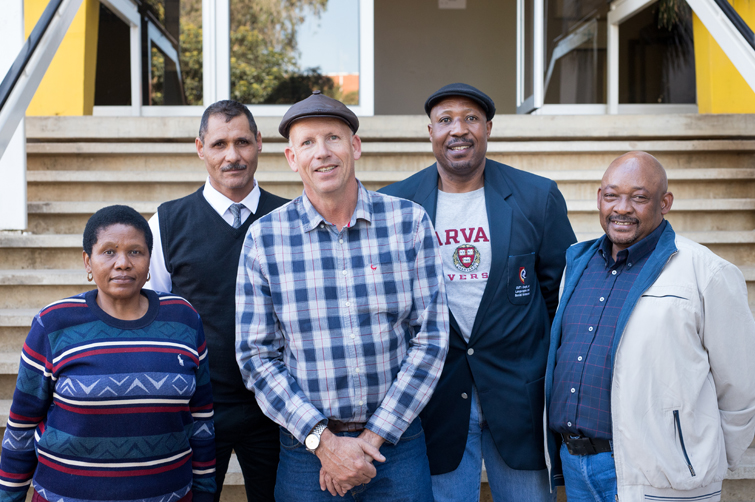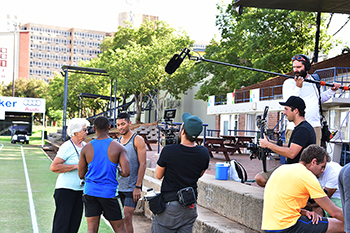Latest News Archive
Please select Category, Year, and then Month to display items
13 January 2020
|
Story Eugene Seegers
|
Photo Anja Aucamp
 Spearheading the digital expansion of the conversational Sesotho course is IDEAS Lab Director, Johann Möller (middle). With him are from the left: Prof Pule Phindane, CUT; Dr Brenton Fredericks, CUT; Bahedile Letlala, UFS Department of African Languages; and Dr Elias Malete, UFS Department of African Languages.
Spearheading the digital expansion of the conversational Sesotho course is IDEAS Lab Director, Johann Möller (middle). With him are from the left: Prof Pule Phindane, CUT; Dr Brenton Fredericks, CUT; Bahedile Letlala, UFS Department of African Languages; and Dr Elias Malete, UFS Department of African Languages.
For many years now, the UFS has been offering a one-year course in conversational Sesotho for staff members; this can then be followed up with the one-year course in advanced conversational Sesotho. The conversational Sesotho for students in the Faculty of Education was introduced in 2018 at the UFS.
The Central University of Technology (CUT) needed a conversational course for its first-year students and approached the Department of African Languages for the development of such a course. Living as we do in a multilingual country; this additional language skill opens doors and often hearts as well.
Using instructional design principles
However, the need was identified by both CUT and UFS to present this crucial information in a way that would be more appealing to digital natives as well as to those less familiar with technology. The Department of African Languages on the UFS Bloemfontein Campus, together with relevant departments from the CUT, approached the IDEAS Lab located on the UFS South Campus, since they already have a reputation for being a specialist on broadcasting and repackaging curricular content for digital presentations. The IDEAS Lab provided technical advice and built the multimedia programme, which will help the user to hear and practice phrases in Sesotho, using instructional design principles. The course will be available to both staff and students belonging to the two universities.
Room for growth
Johann Möller, Director of the IDEAS Lab, says this pilot programme will give both institutions the opportunity to test the use of multimedia for language acquisition. He adds, “Language is extremely complex, and we would like to expand this learning aid in the future.” In fact, the original design has room for growth built into it.
To keep things simple for the user and the building team, it was decided to start out with only four potential everyday scenarios where a staff member would like to speak Sesotho: Firstly, how to greet other persons from different genders; secondly, potential scenarios one might encounter in the university environment itself; thirdly, how to deal with situations at a hospital; and finally, how to use one’s language skills at a filling station.
Pronunciation is key
Each scenario contains three to four conversations that the learner can revise, along with images and audio that illustrate the situation and assist with correct pronunciation. The system does not allow the user to progress unless they have listened to the pronunciations of the sample sentences or phrases.
Further reading material and vocabulary lists are also provided, with the result that people who are using the programme can learn at their own pace. The authoring software Articulate Storyline was used to build the individual scenarios and each conversation or lesson within it. The lessons are also not dependent on an internet connection; they can be downloaded onto a flash memory drive and used offline.
NBC tells Wayde’s story
2015-11-02
 The film crew from NBC Olympics
filming Wayde van Niekerk (centre, in grey clothes)
during a practice session at Pellies Park on the
Bloemfontein Campus of the UFS.
On the left is Ans Botha, Van Niekerk’s coach.
Photo: Charl Devenish |
The Kovsie star Wayde van Niekerk stands an excellent chance of shining at the 2016 Olympics and has a remarkable story behind his success.
This is why NBC Olympics, a division of the American broadcasting network NBC, selected the athlete from the University of the Free State (UFS) to do a special insert for the Olympics in Rio de Janeiro.
A film crew from NBC visited the City of Roses and the Bloemfontein Campus of the UFS on Monday 26 and Tuesday 27 October 2015 to film the insert. The feature will be screened on NBC Olympics’ platforms during and leading up to the Olympics next year.
One of four stars
Van Niekerk was one of four athletes used by the crew to film inserts on. The others were the South African swimmer Chad le Clos, the Kenyan 800 m athlete David Rudisha, and Ethiopian middle- and long-distance athlete Genzebe Dibaba.
The crew interviewed Van Niekerk and his coach Ans Botha, and also paid a visit to Pellies Park during one of his training sessions.
According to Tom Davidson, feature producer at NBC Olympics, the piece about Van Niekerk will be about three minutes long.
“We do a pretty good job of picking good stories, but it is up to the athletes to get there,” Davidson said.
“We think Wayde has a good shot at being in the finals of the 400 m at the Olympics.”
Van Niekerk won a gold medal in a time of 43.48 s at the World Championships in Beijing during August 2015 and set a new South African record for a third time and a new African record for a second time this year in the process.
Beijing success propels Wayde onto NBC radar
“Wayde’s performance in Beijing certainly propelled him onto our radar,” said Davidson.
“He beat former World and Olympic champions like Kirani James and LaShawn Merritt.”
He feels that Van Niekerk is also very young and still at university.
And Botha makes his story even more interesting.
“It is not every day that you see a 74-year old great-grandmother coaching a world champion.”